Everyone knows that keeping your firearms secure is a wise thing to do, but what does “secure” actually mean? If you ask some anti-gun politician, they’ll tell you that no gun is truly secure unless it’s unloaded, disassembled into small pieces, and locked in a vault so secure that opening it requires a procedure similar to a nuclear missile launch authorization. But here in the real world, secure simply means readily accessible to those who should access it and inaccessible to those who shouldn’t. Under normal circumstances, this may mean preventing your young kids from having unsupervised access to your guns; in extreme cases, it can be used as a safeguard against intruders entering your home by force. As with all security measures, you need to start with a realistic threat assessment before spending money on hardware.
Gun Safe vs. Gun Cabinet
Many gun owners assume that a gun safe is the only answer to this question, but that’s not always the case. Gun cabinets or lockers are also an option worth considering.
A proper gun safe will generally be constructed from thick, hardened steel with security features intended to keep determined thieves out. Of course, someone with power tools and/or sophisticated knowledge may be able to breach it, but this should take a lot of time and effort. Gun safes can also safeguard the contents against fire damage. But the trade-off for all this protection is significant weight, bulk, and cost.
On the other hand, a gun cabinet offers a lower level of protection in exchange for significantly lighter weight, convenient installation, and a more affordable price point. If, rather than criminal masterminds, you’re mostly concerned with keeping your guns out of reach from your kids or houseguests (e.g., the babysitter or cable guy), a gun cabinet may be the right choice for you. It’s perfect for “keeping honest people honest,” as the old adage says. Vintage decorative gun cabinets were made from ornate wood and glass with a keyed lock, while more modern options use stamped sheet metal and an electronic combination lock.
Some of the additional advantages of a gun cabinet include increased internal space due to thinner single-layer walls and dramatically improved portability. If you rent a home or live in an apartment, you may not want to install a 300- to 500-pound gun safe that you’ll just have to move in a year or two, but a cabinet can be disassembled and transported in a matter of minutes.
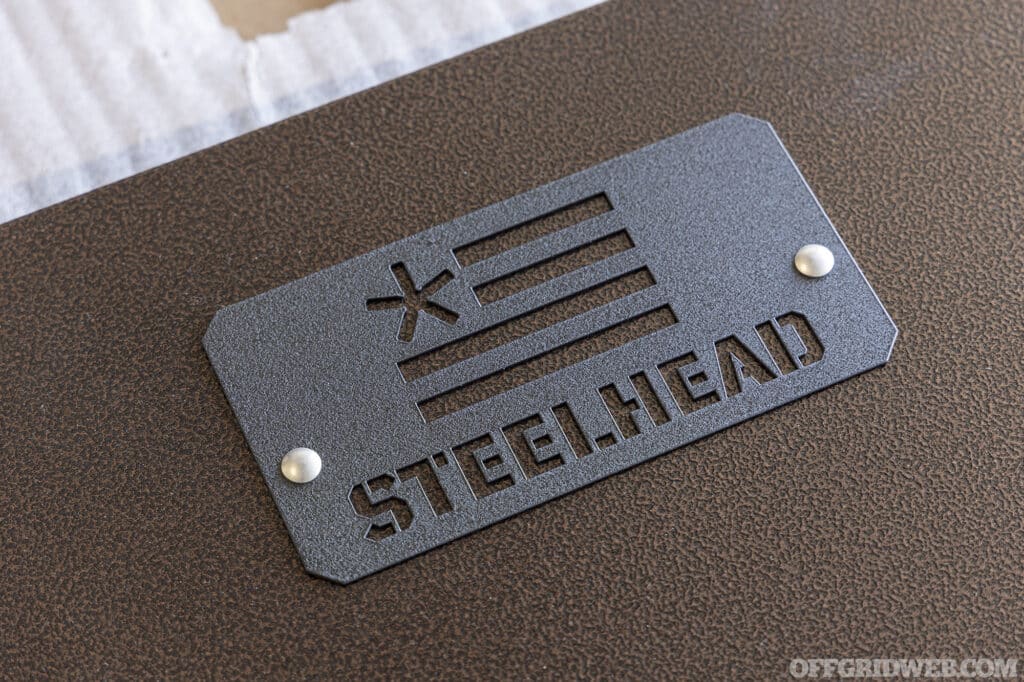
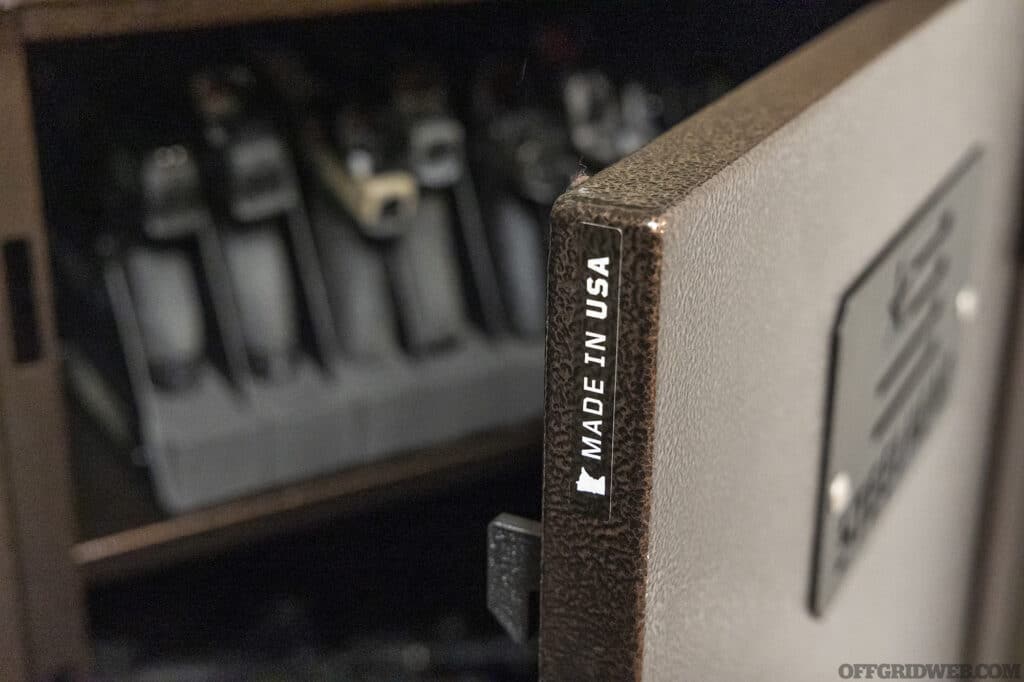
Above: Steelhead calls this color “Badlands Brown,” and I like it much better than the generic gray finish of most other manufacturers’ cabinets. The bolted-on logo is also a nice touch.
Steelhead Outdoors’ American-Made Cabinets
Recently, I had been searching for a new gun cabinet to house some of my ever-growing collection of firearms — I’m sure many of you can sympathize. While it’s possible to find a cheap metal cabinet on Amazon or at your local hardware store, I wanted a high-quality cabinet that’s not just a box of flat-packed panels from China. I also didn’t want to deal with the frustrations of misshapen brackets, incorrectly drilled holes, and missing hardware that usually goes hand-in-hand with those cheaper options. This led me to Steelhead Outdoors, a company founded by two engineers and outdoor enthusiasts in 2016. Steelhead designs and manufactures all its products in Minnesota and offers everything from huge custom-built safes to small pistol lock boxes. Their products come with clear, well-written assembly instructions (not machine-translated gibberish) and are designed to be put together with ease by two people.
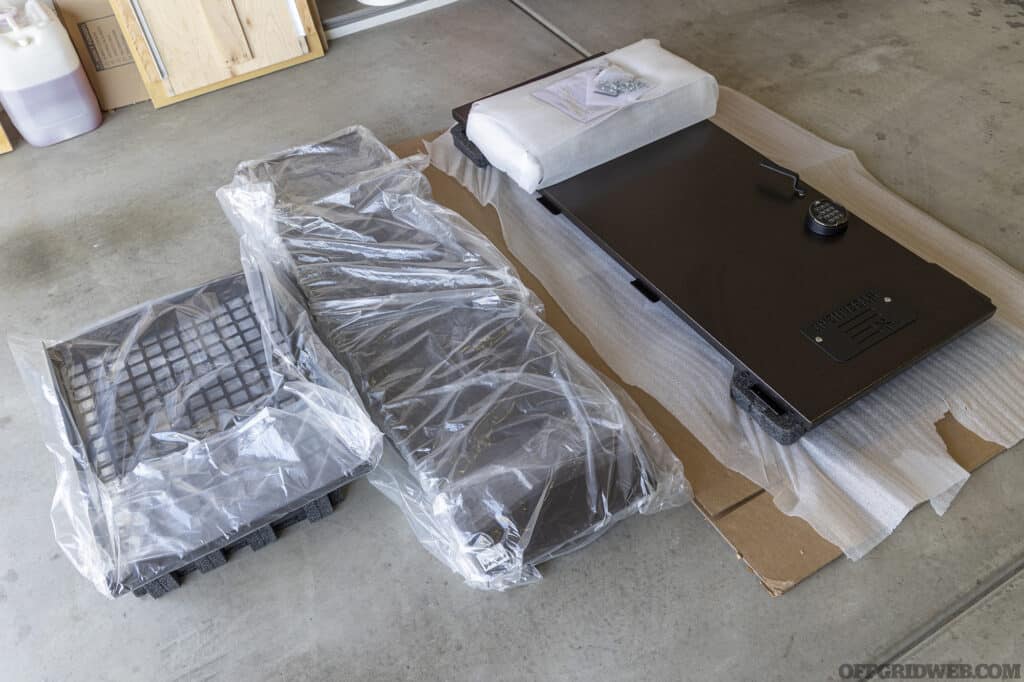
Above: The Scout 25 arrives in four boxes, making it easier to move into position and less costly than one large box.
The Scout 25 is a modular gun cabinet that measures 25 inches wide by 60 inches tall and 15 inches deep. That’s enough for nine long-guns plus an included full-width adjustable shelf for handguns, ammo, accessories, and other gear. The inside of the door also features two removable grid panels that can hold MOLLE-compatible accessories such as pistol holsters, magazine pouches, medical gear, tool kits, suppressors, and much more.
One significant advantage of the Scout cabinet is its ease of transport, both before and after assembly. The cabinet arrives in four boxes, with the heaviest weighing only 60 pounds. This keeps shipping cost at a reasonable $150, much less than you’d spend on a fully assembled safe or cabinet. It’s assembled using basic hand tools, and can be done solo, though a few steps are easier with an extra pair of hands. Total weight of the finished cabinet is 175 pounds. MSRP is $1,600.
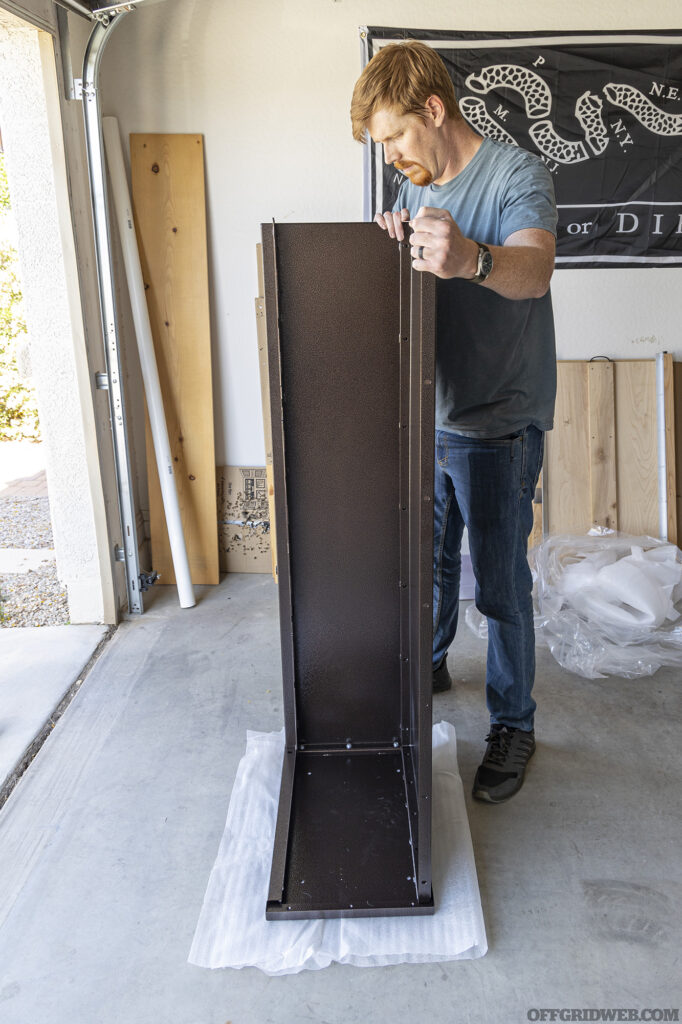
Above: Assembly begins with loosely connecting the sides and back panel to the base.
Security Features
Although the Scout 25 is a gun cabinet, some of its features are more reminiscent of a safe. Rather than a single-point latch or two-point lock bar that could easily be pried apart, it uses a patent-pending vertical beam with eight locking points on the inside edge of the door. This ensures that the entirety of the door clamps shut tightly without easily exploited weak areas. Although it does have external door hinges to allow 180-degree opening, those hinges are protected by internal, inaccessible hardware and four welded dead bolts that keep that side of the door just as secure as the latch side.
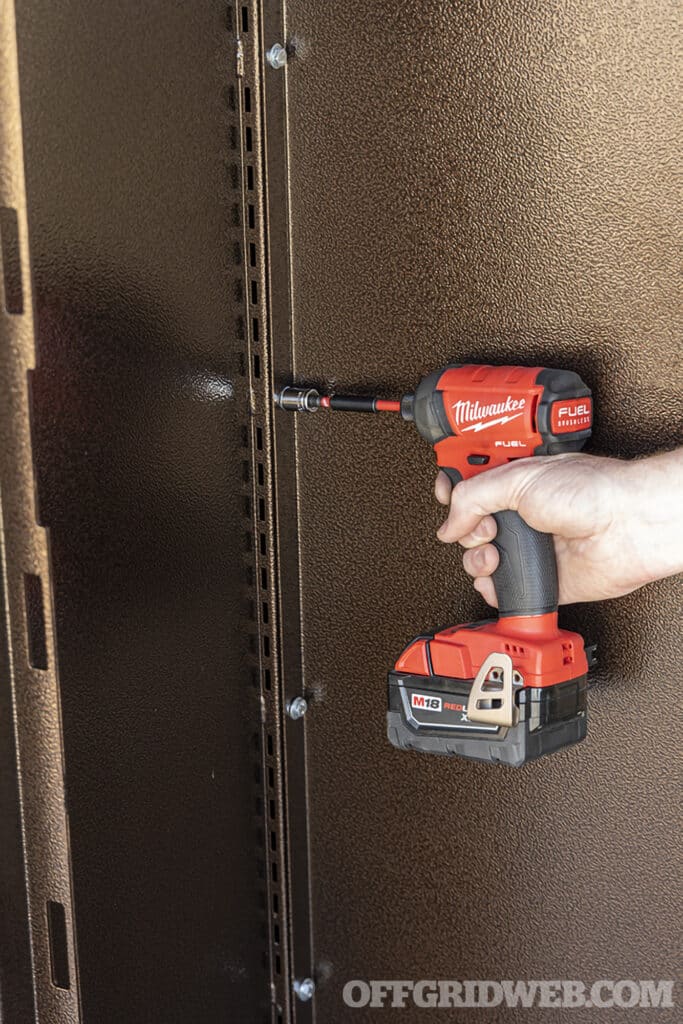
Above: A powered driver can make installing the 40 bolts much quicker but be very careful not to cross-thread or over-tighten any of them.
Anchoring the safe to the wall or floor is required, both for tip-resistance and to ensure potential thieves can’t just carry away the entire cabinet. All necessary anchoring hardware is included with the Scout 25. For concrete floors, you’ll need a hammer drill or impact driver, but, for wood floors or drywall/stud applications, a standard drill is OK.
Steelhead uses Sargent & Greenleaf (S&G) Spartan electronic locks on its cabinets and safes, a type of lock used for applications such as small ATMs. It features a motor-driven locking mechanism, and S&G even says it has been tested to remain functional in the event of an electromagnetic pulse (EMP). The Spartan lock uses a six-digit, user-programmable combination which unlocks the manual latch handle beneath it.
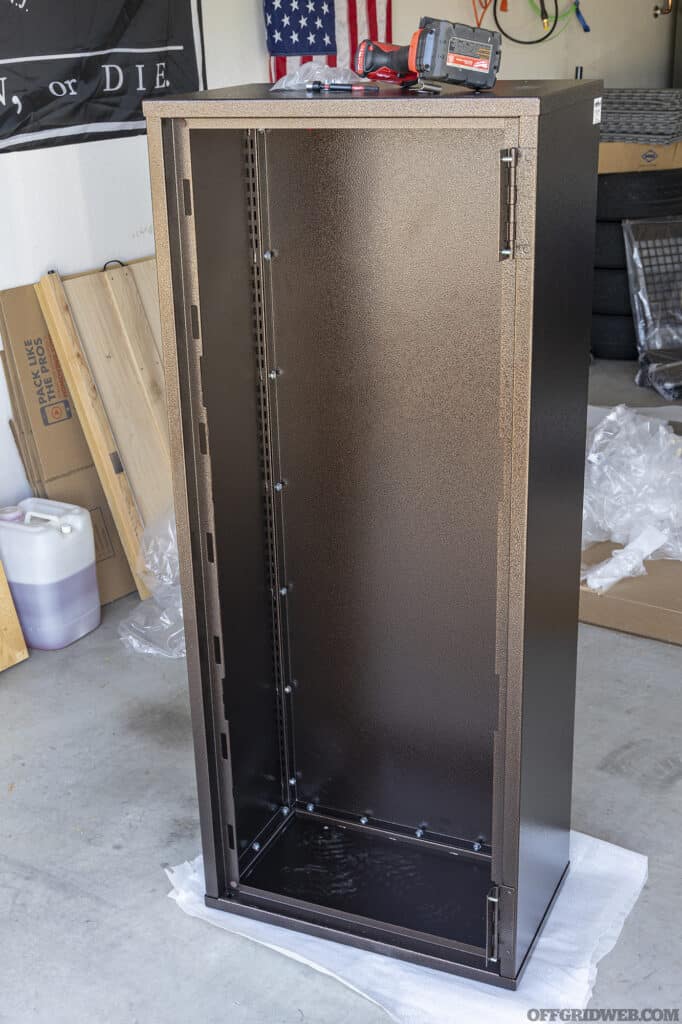
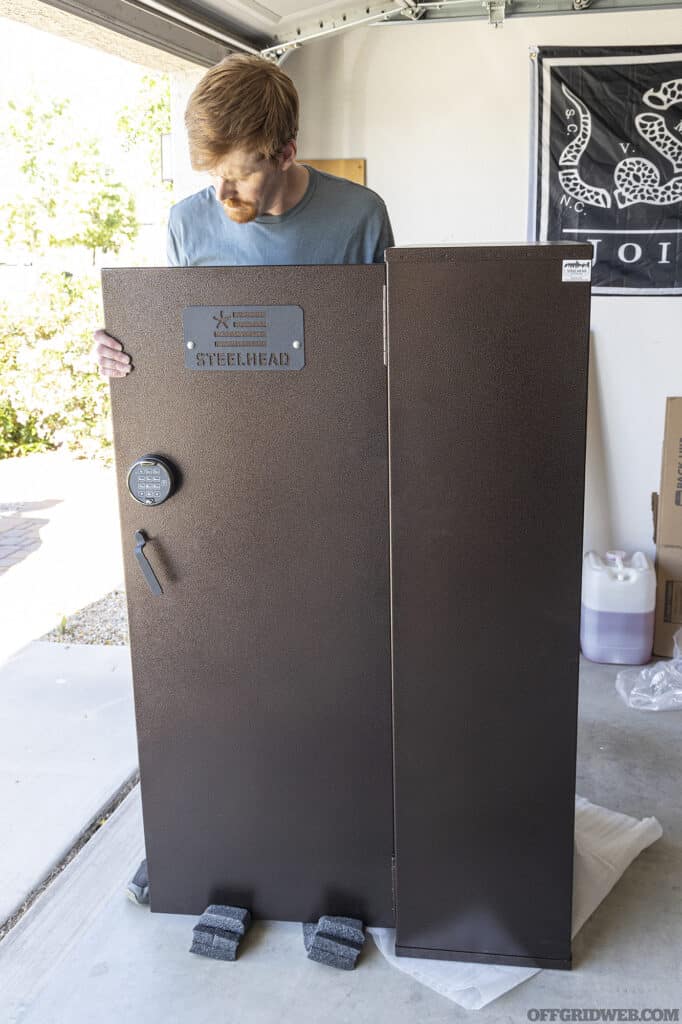
Above: Once the cabinet is assembled and squared up, the door can be positioned and bolted on. A second pair of hands is highly recommended for this step.
A notice that comes with each cabinet explains a master reset code is kept on file for each customer by default, with unique ID data and a decoder kept off site in two separate locations. This allows Steelhead to help if you lose or forget your safe’s combination. However, for customers who wish to opt out of records retention, Steelhead will destroy the master reset code upon request, as long as the customer acknowledges losing the combination after that point will mean calling a locksmith to drill into the safe. I appreciate this level of transparency and openness to user security preferences.
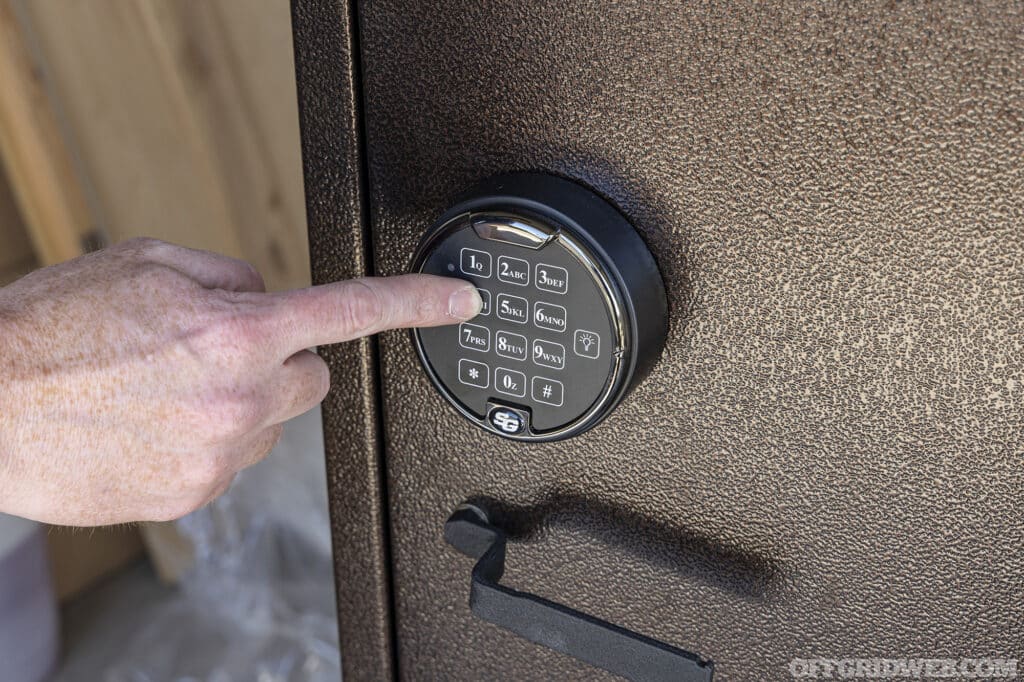
Above: The S&G Spartan digital lock can be programmed with a six-digit combination of your choice. Steelhead will even destroy their records of the master reset code if you request it.
Building the Cabinet
I began by unwrapping and inspecting all the components in my garage. No matter how well Steelhead packs them, shipping carriers tend to smash boxes and damage contents, so it’s always a good idea to check for bent panels before you find out the hard way while putting it together. Thankfully, everything looked OK.
The only tools required are a ¼-inch drive ratchet, extension, and 7/16-inch shallow socket. Steelhead says that 70 in-lb is the appropriate torque spec and warns against the use of power tools or large wrenches. Keeping this in mind, I still used a ¼-inch hex driver on the lowest power setting for the sake of convenience, being extremely careful not to cross-thread or over-tighten any of the 40 bolts. Always start bolts by hand and apply final torque with an appropriate ratchet or torque wrench to avoid damaging the cabinet.
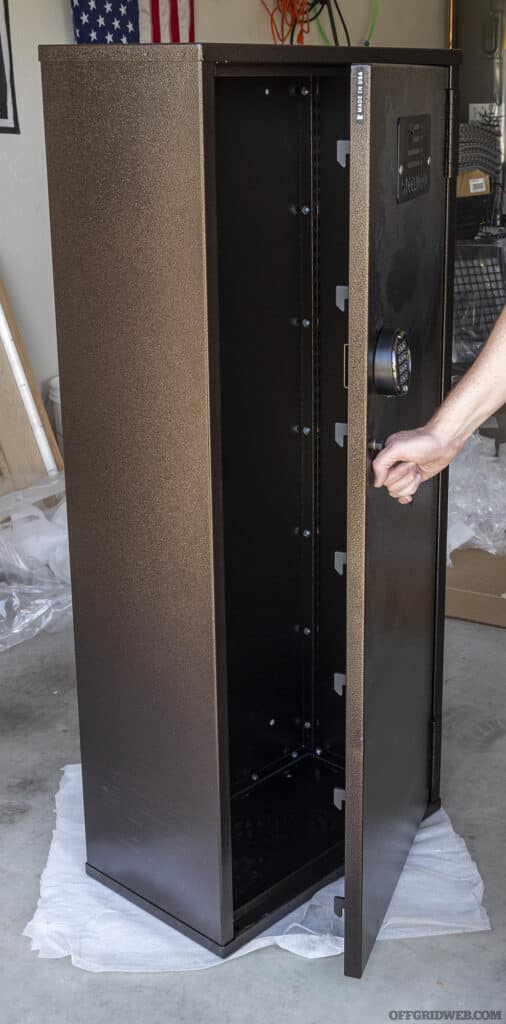
Above: Unlike other cabinets that have only one or two lock engagement points, the Scout has eight along the edge of the door, plus four internal tabs that protect the hinge side against prying.
Assembly is simple, starting by loosely bolting together the bottom panel and left side panel, then the back, right side, and top. It’s much easier if someone can help you by holding the panel as you insert bolts with washers, but the panels are light enough that it could be done alone in a pinch. Once the five main panels are together, check that all of them fit tightly without gaps and appear square. Then, tighten the top, bottom, and back panel bolts, followed by the four front-facing bolts.
To install the door, make sure it’s unlocked using the default code and position it in front of the cabinet on top of some of the foam packing blocks. Slowly slide it up to the cabinet at a 90-degree angle, center the four studs on the hinges, and gently tighten the four nuts to hold the door in place. Ensure the door closes smoothly without any misalignment — mine barely grazed one edge of the cabinet, so I loosened and repositioned it before applying final torque to the hinge nuts.
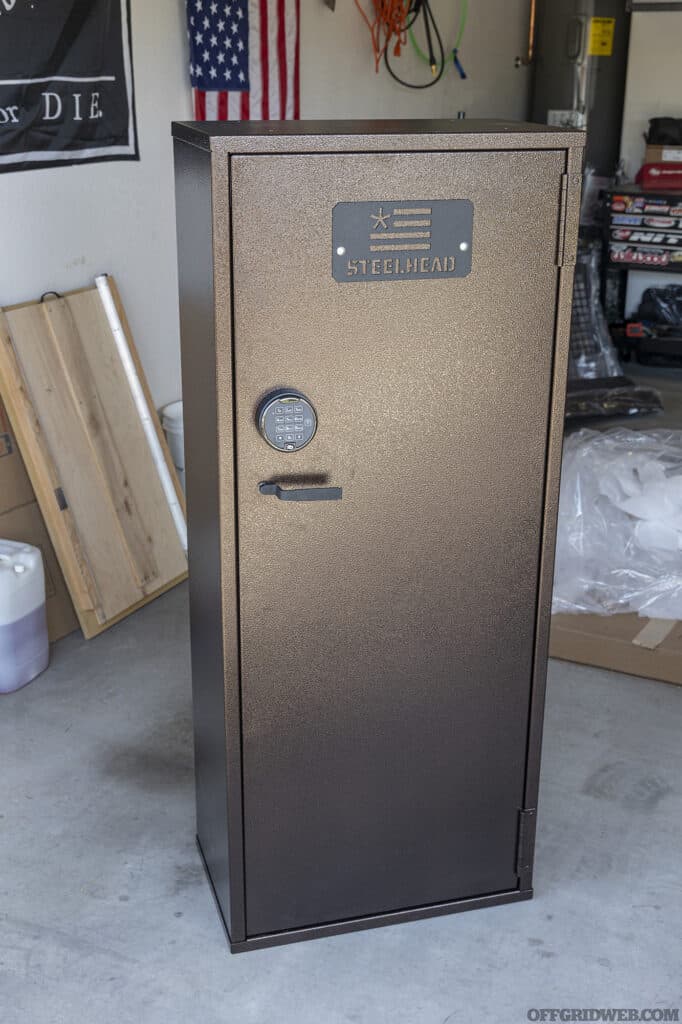
Steelhead Outdoors Info
URL: steelheadoutdoors.com
Lastly, I installed the included shelf, which slides into a pair of slotted tracks just like any industrial shelving. It’s at the perfect height for a Savior Equipment pistol rack at the top of the cabinet, even with a suppressed 18-inch rifle in the long-gun rack below it. I also bolted the two gear panels to the inside of the door, which can be used to organize additional gear in the future.
Read More
Subscribe to Recoil Offgrid's free newsletter for more content like this.
Editor's Note: This article has been modified from its original print version for the web.
The post Steelhead Outdoors: Scout 25 Review appeared first on RECOIL OFFGRID.
By: Patrick Diedrich
Title: Steelhead Outdoors: Scout 25 Review
Sourced From: www.offgridweb.com/gear/steelhead-outdoors-scout-25-review/
Published Date: Fri, 09 Aug 2024 13:16:01 +0000
------------------------
 What is BushcraftSurvival SkillsToolsVideosBushcraft CampsBushcraft KitsBushcraft ProjectsPrivacy PolicyTerms And Conditions
What is BushcraftSurvival SkillsToolsVideosBushcraft CampsBushcraft KitsBushcraft ProjectsPrivacy PolicyTerms And Conditions
